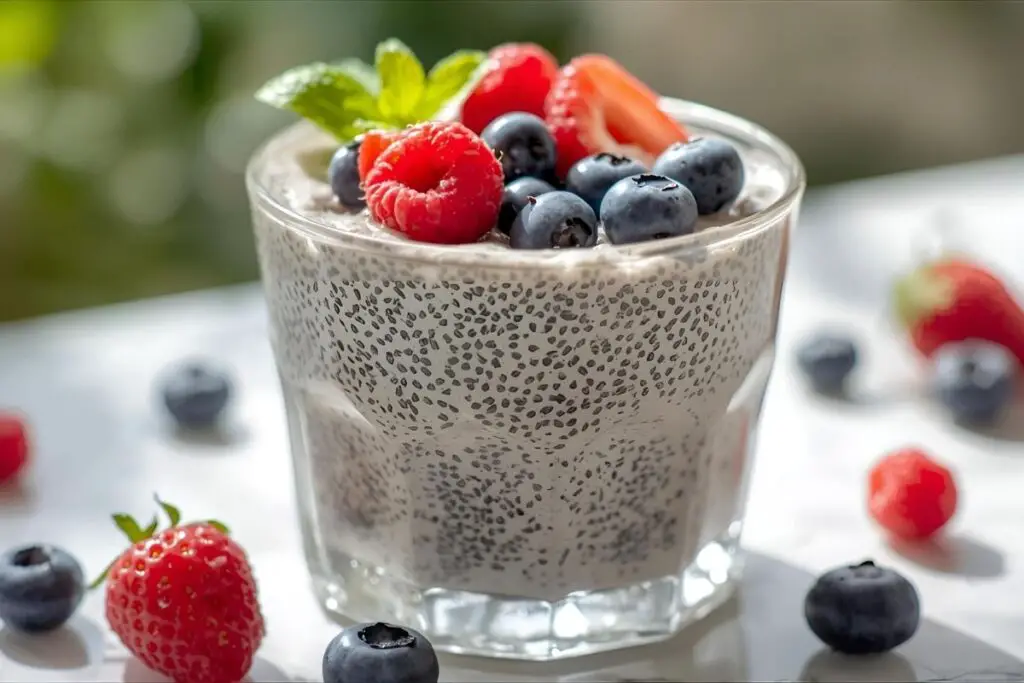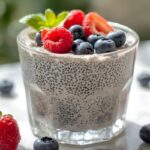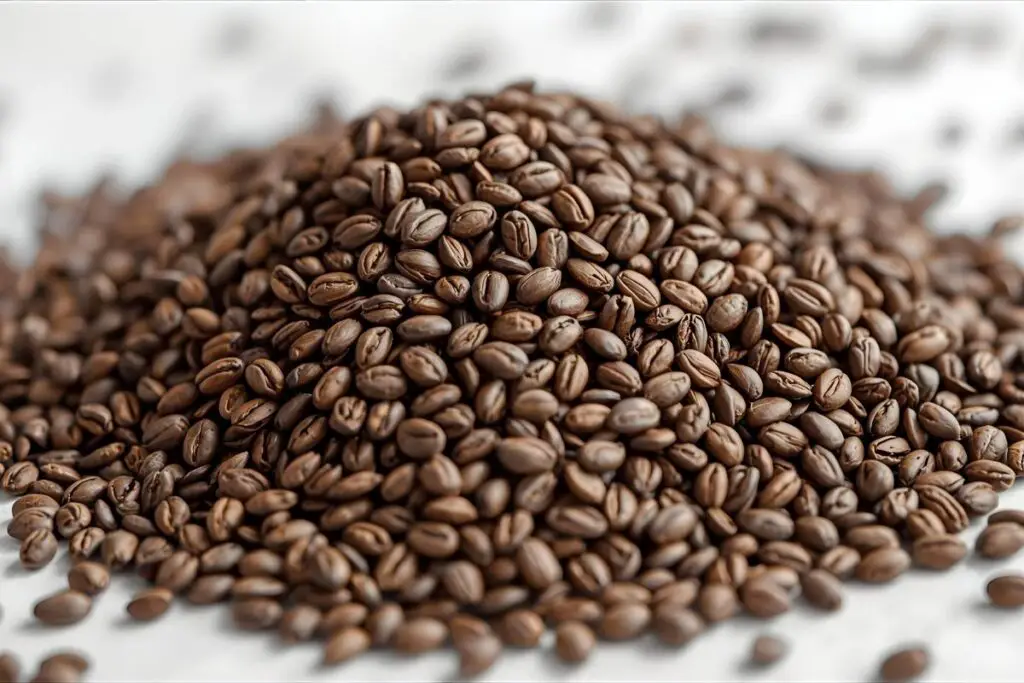Table of content
Table of Contents
Introduction

Chia seeds have taken the health and wellness world by storm, and for good reason. Tiny but mighty, these little seeds pack a nutritional punch that can boost your energy, improve digestion, and even support heart health. But if you’re new to chia seeds, you might wonder, how to eat chia seeds in a way that’s both tasty and enjoyable. The good news? Incorporating chia seeds into your daily diet is easier than you think—and it doesn’t have to be boring.
Whether you want to sprinkle them on your breakfast, blend them into smoothies, or whip up some chia pudding, this guide will walk you through five delicious ways you’ll love trying chia seeds. Each method is not only packed with flavor but also simple enough for any busy lifestyle. Plus, you’ll find tips about their texture, soaking times, and pairing ideas, so you can make the most of this superfood. Ready to discover how to eat chia seeds naturally and deliciously? Let’s dive in!
Ingredients List
Before you start experimenting with chia seeds, it’s helpful to have a well-rounded ingredients list that offers flexibility and flavor.
Chia Seeds (2–3 tablespoons)
These tiny seeds absorb liquid and swell up, creating a gel-like texture. Their mild, nutty flavor means they can blend into a variety of recipes. You can choose black or white chia seeds; both have similar nutritional profiles, but white chia seeds are often preferred for aesthetic reasons in lighter dishes.Liquid Base (1 cup)
For soaking chia seeds, you’ll need a liquid like water, almond milk, coconut milk, or even dairy milk. Unsweetened plant-based milk enriches your dish without added sugars, and it’s great for vegan or lactose-intolerant diets.Natural Sweeteners (optional)
Honey, maple syrup, agave nectar, or stevia all work well. Use these sparingly or omit them if you prefer to reduce your sugar intake. Sweeteners give life to chia puddings and smoothies, balancing the mild taste of chia seeds nicely.Fruit (fresh or frozen)
Fresh berries, mango, banana, or kiwi are wonderful options for adding natural sweetness and texture. You can blend these into your chia pudding or use them as a topping.Flavor Enhancers
Vanilla extract, cinnamon, cocoa powder, or a pinch of salt add extra layers of flavor and complexity. These are especially nice if you’re making chia puddings or overnight oats.Optional Add-ins
Each ingredient matters because chia seeds’ true magic is in how they absorb moisture to transform the dish’s texture and nutrition. Selecting complementary ingredients ensures a perfectly balanced, delicious final product.
Nuts, granola, coconut flakes, or nut butter can make your chia seed dishes crunchier and more satisfying.
Timing
One of the biggest keys to knowing how to eat chia seeds properly is understanding timing. When soaked, chia seeds take about 15–30 minutes to absorb liquid and form a gel-like consistency, though overnight soaking often yields the best texture and digestibility. Cooking chia seeds isn’t usually necessary unless you’re using them as a thickening agent in hot dishes like soups or smoothies.
Prep time varies depending on the recipe. For example, chia pudding requires minimal hands-on time but benefits from several hours to hydrate fully. On the other hand, sprinkling chia seeds over salads or yogurt only adds seconds. Total time can stretch from a few minutes for simple uses to a few hours for dishes needing soaking. Proper timing not only enhances the texture but also optimizes nutrient absorption, so planning ahead is a win-win.
Step-by-Step Instructions
Print
How to Eat Chia Seeds: 5 Delicious Ways You’ll Love
- Total Time: 10 mins
- Yield: 2 servings
Description
Chia seeds are tiny nutritional powerhouses that can transform your meals into superfood delights. Whether you soak them for pudding, blend them into smoothies, or sprinkle them on salads, they offer fiber, protein, and heart-healthy omega-3s in every spoonful. This recipe shows you exactly how to eat chia seeds in five delicious and easy ways—perfect for breakfast, snacks, or even desserts!
Ingredients
- 2–3 tablespoons chia seeds (black or white)
- 1 cup liquid (water, almond milk, coconut milk, or dairy milk)
- 1–2 teaspoons natural sweetener (honey, maple syrup, or agave – optional)
- Fresh fruit (berries, mango, banana, or kiwi)
- ½ teaspoon flavor enhancers (vanilla, cinnamon, or cocoa powder – optional)
- Optional add-ins: nuts, granola, coconut flakes, or nut butter
- Prep Time: 10 mins
- Cook Time: 0 mins
- Category: Weight Loss Meals
- Method: No-Cook, Soak
- Cuisine: International
Step 1: Soak Your Chia Seeds
Start by mixing 2–3 tablespoons of chia seeds with 1 cup of your chosen liquid. Stir well to prevent the seeds from clumping together. Let them sit for at least 15 minutes, though ideally 2 hours or overnight in the fridge for the best texture. Pro tip: Stir once or twice during soaking if you don’t leave them overnight to evenly hydrate the seeds. Soaking activates the gelatinous texture, making chia seeds edible and easy on digestion.
Step 2: Sweeten and Flavor
Once your chia seeds have absorbed the liquid, add a natural sweetener like honey or maple syrup. This step can be personalized based on preference or dietary needs. For added complexity, include vanilla extract or a pinch of cinnamon. These flavorings complement the earthiness of chia seeds and enhance the overall taste profile without overwhelming it.
Step 3: Mix in Fruits and Add-ins
Add chopped fresh or frozen fruits like berries, mango, or banana for natural sweetness and vibrant color. For texture, consider sprinkling in nuts, granola, or shredded coconut. Mixing these elements transforms simple chia seeds into a robust and satisfying meal or snack. Variations can include layering the chia pudding with fruit purees or creating parfaits in glass jars, perfect for meal prep or breakfast.
Step 4: Let Flavors Meld and Serve
Allow your chia pudding or mixture to chill for at least another 30 minutes after adding fruit and sweeteners. Chilling lets flavors meld beautifully and thickens the pudding further. If you’re using chia seeds in smoothies or oatmeal, blend or cook accordingly. Cooking science tells us chia seeds will continue to thicken mixtures as they cool, so patience pays off here.
Step 5: Serve and Enjoy
Presentation matters! Spoon your chia pudding into a bowl or jar, then top with fresh fruit, nuts, or a drizzle of nut butter for extra appeal and nutrition. For a refreshing twist, serve it chilled on hot days, or add it as a topping to warm breakfasts like oatmeal or pancakes. Keep portions reasonable—typically one serving is around ¼ cup of dry chia seeds transformed after soaking—to enjoy the benefits without excess calories.
Nutritional Information
Chia seeds are nutritional powerhouses. In about 2 tablespoons (roughly 28 grams), you get:
- Calories: 138
- Protein: 5g
- Fat: 9g (mostly polyunsaturated omega-3 fatty acids)
- Carbohydrates: 12g (includes 10g fiber)
- Calcium: 18% of the daily value
- Iron: 12% of the daily value
The standout nutrient here is fiber, which supports digestive health, promotes fullness, and stabilizes blood sugar. Omega-3 fatty acids promote heart and brain health. Protein content makes chia seeds a fantastic plant-based option, especially for vegans or vegetarians. Their nutrient density offers a small but significant contribution to your daily vitamin and mineral needs with very few calories.
Healthier Alternatives for the Recipe

If you want to mix things up or tailor the recipe to specific diets and flavor preferences, consider these variations:
Flax Seeds – Another omega-3 rich seed with a similar texture when soaked. Slightly nuttier but equally nutritious.
Hemp Seeds – Higher in protein and healthy fats, hemp seeds provide a softer texture and a mellow, earthy flavor.
Quinoa Seeds – Cooked quinoa can add protein and a fluffy texture to your chia seed dishes, especially in puddings and salads.
Psyllium Husk – For extra fiber and a thickening effect, though it lacks the protein and omega-3 of chia seeds.
Ground Chia Seeds – Easier for digestion and mixing, ground chia can be used in smoothies, baked goods, or as an egg substitute in vegan cooking.
Each alternative offers unique health benefits and textural differences, so feel free to experiment based on what suits your nutritional goals and taste preferences.
Serving Suggestions
Chia seeds are incredibly versatile and can be incorporated into meals for any time of day. For breakfast, top chia pudding with fresh berries, a sprinkle of granola, and a dollop of Greek yogurt. In warmer climates or seasons, chilled chia pudding makes a refreshing, hydrating snack.
In many Latin American countries, chia seeds are traditionally soaked with water and lime as a hydrating drink called chia fresca, which you can enjoy as a natural energy boost during hot days. You can also elevate your salads by sprinkling chia seeds over them, adding a subtle crunch and nutritional boost. For dessert enthusiasts, mixing chia pudding with cocoa powder and avocado creates a creamy, guilt-free chocolate mousse.
Seasonally, pair chia seeds with fruits in season such as peaches and nectarines in summer or apples and cinnamon in fall. Their neutral flavor makes them a perfect backdrop for a wide variety of cultural dishes and fresh ingredients.
Common Mistakes to Avoid
Skipping Soaking – Eating dry chia seeds can cause choking or digestive issues. Always soak for safety and optimal texture.
Using Too Few Liquids – Insufficient liquid leads to clumping and unpleasant texture. Follow the recommended 1:6 chia-to-liquid ratio for pudding.
Eating Too Many at Once – While healthy, too much fiber suddenly can upset your stomach. Start with small servings and increase gradually.
Not Stirring During Soaking – Seeds can clump at the bottom if not stirred initially. Stir right after mixing and a couple of times during soaking.
Adding Chia Seeds at the Wrong Time – For smoothies or hot dishes, adding chia too early can thicken the mixture too much, making blending harder.
Fixing these mistakes ensures a pleasant eating experience and maximizes chia seeds’ health benefits.
Storing Tips for the Recipe
Chia seeds themselves have a long shelf life—up to two years when stored in a cool, dry, airtight container. Once soaked, chia pudding can be stored in the refrigerator for up to 5 days, making it perfect for meal prepping breakfasts or snacks.
For longer storage, chia pudding can be frozen in individual portions for up to 2-3 months. To thaw, place it in the fridge overnight and stir well before serving as the texture might slightly change. Avoid soaking large amounts in liquid and leaving it at room temperature for extended periods as this can lead to spoilage.
Meal prep savvy: Make your chia puddings in mason jars, layer your ingredients, and store for grab-and-go convenience.
Conclusion
Learning how to eat chia seeds cleverly unlocks a host of health benefits wrapped in delicious meals and snacks. From creamy puddings to crunchy toppings and refreshing drinks, chia seeds add texture, nutrition, and versatility with minimal effort. Whether you’re a health enthusiast or just starting your wellness journey, adding chia seeds to your diet is an easy, tasty choice that supports digestion, energy, and overall vitality. So why wait? Try one (or all!) of these five delicious chia seed ideas today and enjoy the natural boost they provide to your meals!
If you’ve been curious about how to eat chia seeds in fun and nourishing ways, you’ll love how versatile they can be. From refreshing drinks like lemon and chia seed water and classic chia seed water to creative snacks and meals, there are endless options to explore. Health experts even highlight 35 delicious ways to enjoy chia seeds—proving they’re much more than just a superfood trend. And if you prefer a visual guide, this step-by-step video shows how simple it is to prepare chia seeds for maximum nutrition and taste.
FAQs
Q: Can I eat chia seeds raw?
A: Eating dry chia seeds directly is not recommended because they can absorb water and swell in your throat, posing a choking hazard. Always soak them in liquid first to create a gel-like texture that’s safe and easy to digest.
Q: How much chia seed should I eat daily?
A: Most adults benefit from 1 to 2 tablespoons of chia seeds daily. Start with smaller amounts, especially if you’re not used to high-fiber foods, and gradually increase to avoid digestive discomfort.
Q: Are chia seeds gluten-free?
A: Yes, chia seeds are naturally gluten-free, making them an excellent addition to gluten-free diets. However, ensure you buy from a certified gluten-free source if you have celiac disease or severe gluten intolerance.
Q: Can chia seeds help with weight loss?
A: Yes, due to their high fiber and protein content, chia seeds can promote fullness and reduce appetite, helping with weight management when combined with a balanced diet and exercise.
Q: How do chia seeds affect digestion?
A: Chia seeds are rich in soluble fiber, which absorbs water and forms a gel that slows digestion. This process supports regular bowel movements and can soothe the digestive tract.
Q: Can chia seeds be used in baking?
A: Absolutely! Ground chia seeds can replace eggs as a binding agent in vegan baking or be added whole to provide texture and nutrition in breads and muffins.
Q: Are there any side effects of eating chia seeds?
A: For most people, chia seeds are safe. However, consuming very large amounts suddenly may cause digestive discomfort like bloating or gas due to the high fiber. Stay hydrated and increase intake gradually.
